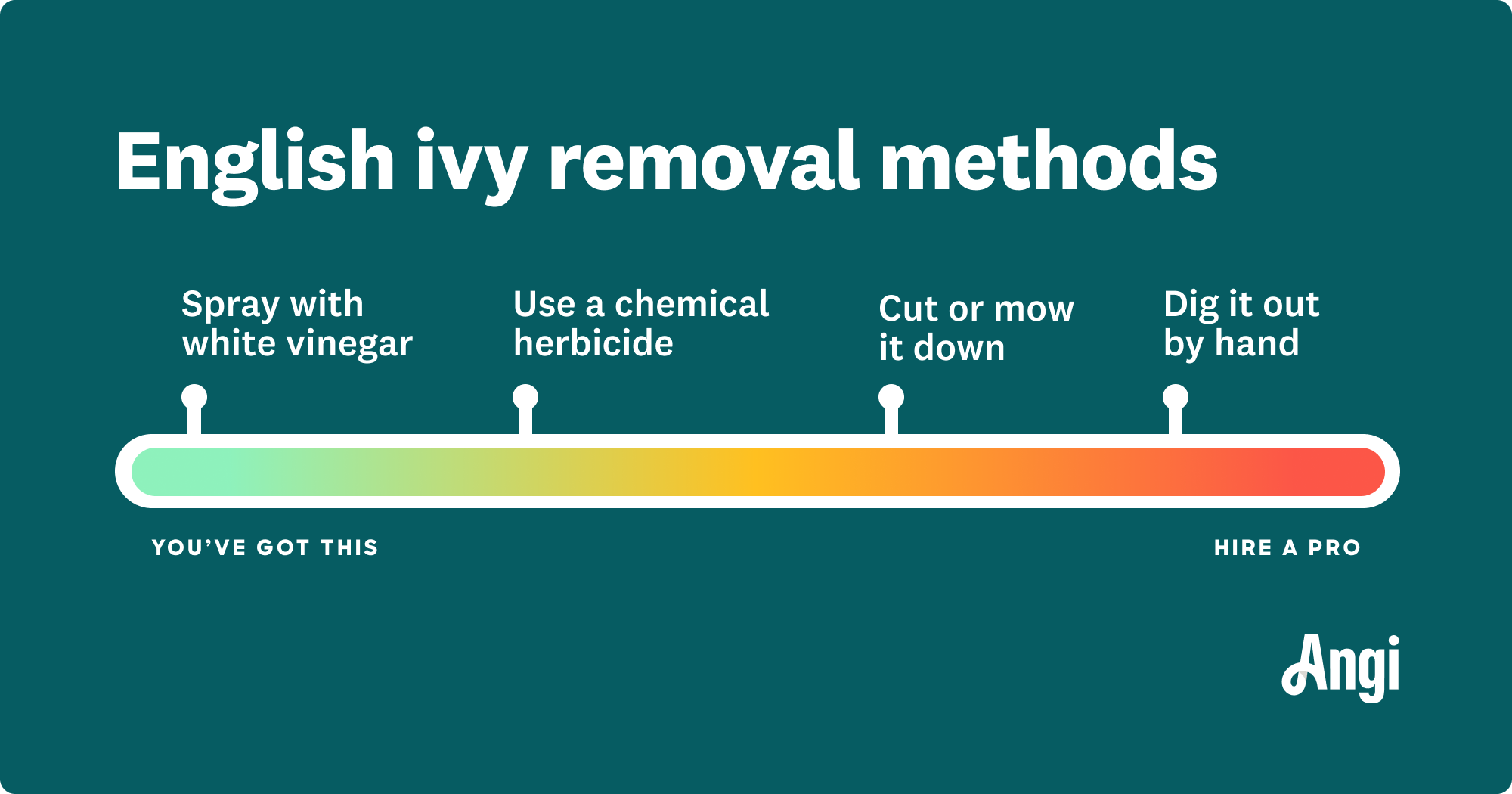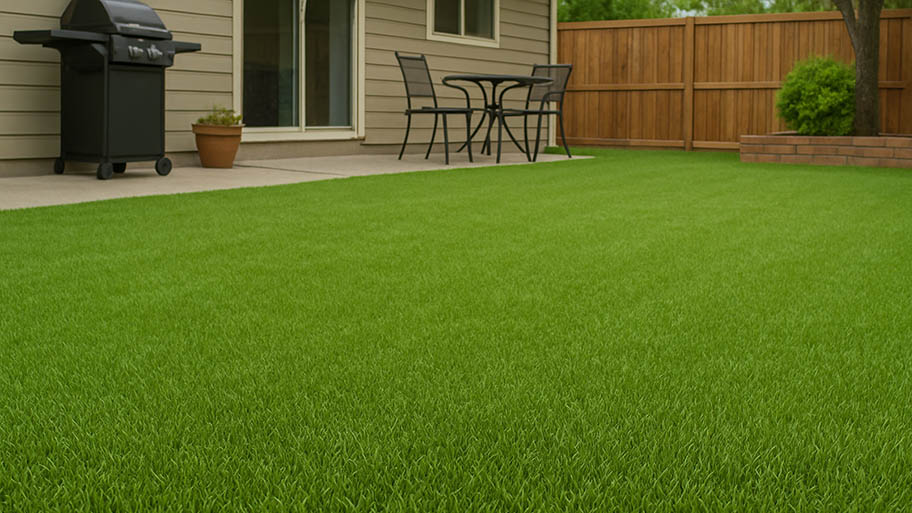
Your total lawn care cost depends on several factors, including the type of service and lawn size. Our guide will cover what you can expect to pay for lawn care.
Ground English ivy before it takes over


Sure, English ivy covering the side of your home can make it look like you live in a storybook cottage, but that plant is actually trying to take over. This invasive plant can cause serious damage to your house and be a home for uninvited rodents.
Here’s how to kill that ivy—and fast.
English ivy, or Hedera helix, is a fast-spreading vine that quickly snakes around trees, shrubs, other plants, and houses. Because of its aggressive nature, it’s considered an invasive plant species in the United States. It's an evergreen, perennial plant and comes back every year.
The vines, which can reach 90 feet long and 1 foot wide, are either trailing or climbing. A waxy substance covers ivy leaves that’s difficult for herbicides to penetrate.
This plant grows best in moist, rich, well-drained soil in partial or full shade. The ivy tends to grow slowly the first year but, after that, can grow up to 9 feet every year.
Great experience from start to finish. They responded to my inquiry quickly and came out to give me a quote the same day. My yard was overgrown with weeds and needed lots of trimming. The guys came out and pulled all of the weeds by hand to get them out by the roots and trimmed up nicely. They were able to come up with a treatment plan within my budget to get my lawn and yard looking great again. Very professional, efficient and knowledgeable.

Contained in a pot or hanging basket, an ivy plant adds a rich pop of greenery to any space. Plus, ivy as a houseplant helps promote cleaner air. And while you may be tempted to use it as ground cover or let ivy climb the side of your house and create a charming country-forest vibe, don’t give in to its charms!
It may look beautiful, but uncontained, ivy is an invasive plant that grows quickly and is hard to control. And because it returns every year, the cold winter does little to free your yard, trees, and house from ivy’s grasp once it gets a good hold.
As ivy creeps around the yard, it covers almost every native plant it meets. It sucks up the sunlight and nutrients for itself, starving everything in its path.
If the ground cover starts climbing trees, there are even more issues. The vines can strangle the tree. The weight of the ivy can damage the tree bark and make the tree less sturdy.
The “ick” factor is high in this argument for getting rid of English ivy. The thick, dense foliage appeals to rodents, spiders, and snakes. They can reside in its dark comfort, mere feet away from where you’re grilling out or playing with your kids. If you end up with these uninvited residents, find a local pest removal company to remove them.
Native plants and your favorite backyard tree may not be the only victims of English ivy. The invasive plant can also take over your house.
As ivy climbs the exterior of your home, it’s digging its roots into the weak points of your walls. It may even work its way under your siding and around your windows. Before you know it, the ivy that looks pretty climbing up your house has caused thousands of dollars of damage.
An ivy leaf can be poisonous if it’s consumed. It may cause severe vomiting, breathing problems, coordination issues, and hallucinations. Ivy is not a pet-friendly plant. If your dog or cat decides to nibble on a vine, it could poison them and create symptoms like hypersalivation, abdominal pain, and diarrhea, according to the ASPCA.

Now that we’ve talked about all the havoc that uncontained English ivy can wreak, let’s look at how to get rid of aggressive English ivy vines in your yard.
If you want to use organic weed control for an eco-friendly yard, a natural remedy for ivy removal is household white vinegar. It’s a non-toxic alternative to herbicide, and you probably already have it in your house.
Pour your vinegar into a spray bottle or, even better, a garden sprayer. For extra potency, add 1 tablespoon of salt to every gallon of vinegar.
Before heading outside, put on some sturdy shoes, long pants, a long-sleeve shirt, work gloves, and safety glasses. While battling English ivy isn’t as fraught with danger as, say, trying to kill poison ivy, it can still irritate your skin.
Get close to the vine and thoroughly cover every leaf, root, and surrounding soil with white vinegar. Make sure you don’t spray any of the other plants close by.
Check the ivy in a week to see if it’s dying or dead. Dead ivy will be brown. If it’s dead, pull up the ivy and place it in a heavy garbage bag. If you see green leaves on the ivy, re-apply the white vinegar mixture and check it in a few days.
One of the most effective ways to eliminate English ivy is to chop it. You can use a weedeater, pruners, or heavy-duty gardening shears. You can even use a lawnmower if you know there aren’t any rocks or tree limbs under the ivy.
Ground: Mow the ivy ground cover slowly. Rake the ivy pieces up and put them in a large garbage bag. Otherwise, they’ll figure out a way to root back into the ground.
Trees: For ivy growing on trees, don’t yank the ivy off because it will damage the tree bark. Use pruning shears to chop the ivy down near the tree trunk. Look at the tree’s roots and cut any ivy you see around them to keep the tree from being strangled. The dead ivy will fall off the tree.
House: Ivy removal from walls takes some manual labor and patience. Start by cutting the vines at the base of your wall, right above ground level. Check it in a few days, as dead ivy is easier to pull off the walls. Dispose of it immediately.
English ivy roots typically grow 2 to 5 feet into the soil surface and may spread 10 feet from where they originated.
Cut the ivy. Dig a spade into the soil as far as it will go. Work the spade under the ivy root until you can see it. Pull it up if you can. If it’s anchored by other roots, cut those away and pull the root structure out of the ground.
If the ivy’s been in your yard for a long time, you most likely didn’t get every root on the first try. Continue working your spade around the soil and pull out any additional roots you expose.
The easiest way to get rid of English ivy is with an herbicide. If your ivy has been around for many years or has spread to a large area of your yard or house, vinegar and digging out its roots may not get rid of it completely.
When you’re purchasing an herbicide, glyphosate is your best choice. It’s a popular weed killer that’s widely used for controlling broadleaf weeds.
Spray the herbicide on your offending ivy when it’s cooler weather. This gives it more time to penetrate through the plant’s waxy leaves and decreases the chances the herbicide will evaporate before doing its job.
Wait a few days and check the ivy. If it’s dead, pull it up (or down) and dispose of it carefully.
Covering ivy with a tarp or a heavy plastic sheet will block out the sun and drain the plant’s energy stores. You won’t have to do any digging with this method, but make sure that the tarp blocks all sunlight. The downside to this route is that it can take longer than other applications like herbicides. The tarp method can take a year or longer to kill the ivy.
Ivy removal is one thing; keeping it gone is another. After you’ve sprayed, dug, cut, and pulled it out of your yard and off your trees and house, diligently watch for new sprouts of the aggressive plant and remove it immediately.
Use a thick layer of mulch on the cleared ground. If it tries coming back, the mulch will be a powerful obstacle. A mulching company near you can help spread the mulch around your yard to stop the spread of ivy.
From average costs to expert advice, get all the answers you need to get your job done.

Your total lawn care cost depends on several factors, including the type of service and lawn size. Our guide will cover what you can expect to pay for lawn care.

Artificial grass is a low-maintenance alternative to traditional turf. Learn how much artificial grass installation costs and what affects your price.

The cost to reseed a lawn can vary depending on the size of your yard and the condition of the soil. We’ll help you figure out the true cost of reseeding or overseeding your lawn, along with whether or not you should hire a professional.

Why is my yard so soft and soggy? Use this helpful guide to diagnose the issue and implement a solution that will restore your yard’s health.

Learn how to mow a lawn no matter the type of grass and condition. Achieve a beautifully cut lawn that looks professional using this guide.

Have you been wondering, “Why is my yard lumpy?” Learn about the likely causes of a bumpy yard and what you can do to flatten it out for good.